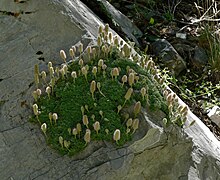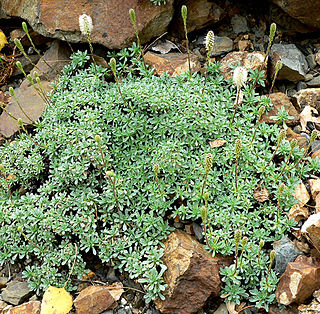
Petrophytum is a small genus of plants in the rose family known as the rock spiraeas or rockmats. These are low mat-forming shrubs which send up erect stems bearing spike inflorescences of flowers. The brushy flowers are white and have many stamens and hairy, thready pistils. Rockmats are native to western North America.

Pilosella caespitosa is like several other Pilosella species and has a similar appearance to many of the hawkweeds.
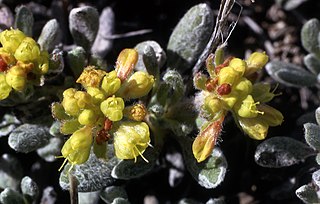
Eriogonum caespitosum is a species of wild buckwheat known by the common name matted buckwheat, mat buckwheat, or cushion desert buckwheat. It is a common perennial plant native to the western United States from California to Montana, especially the Great Basin. Flowering early in the summer, it is also cultivated as a rock garden plant.

Geranium carolinianum is a species of geranium known by the common name Carolina crane's-bill, or Carolina geranium. This species is native to North America, where it is widespread and grows in many types of habitat. There are two varieties; Geranium carolinianum var. carolinianum and the Geranium carolinianum var. sphaerospermum. This is a summer or winter annual herb. It can be considered invasive depending on the region, when it is found in the United States it is considered to be native.
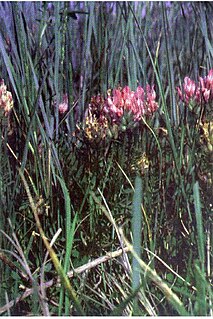
Astragalus agrestis is a species of milkvetch known by the common names purple milkvetch, purple loco, and field milkvetch. It is native to much of western and northern North America from most of Canada to the southwestern United States, as well as eastern Asia. It grows in vernally moist areas such as meadows, and is often found in sagebrush.
Astragalus tidestromii is a species of milkvetch known by the common name Tidestrøm's milkvetch. It is native to the Mojave Desert of California and Nevada, where it grows in limestone gravel soils. The plant is named for the botanist Ivar Frederick Tidestrøm.
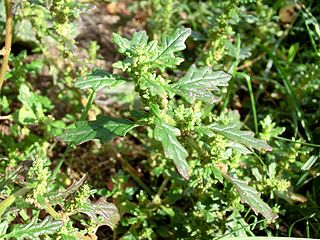
Dysphania pumilio is a species of flowering plant in the family Amaranthaceae known by the common name clammy goosefoot.

Cryptantha flavoculata is a species of flowering plant in the borage family known by the common name roughseed cryptantha. It is native to the western United States from California to Montana, where it is common in many types of habitat. It is a perennial herb growing an unbranching stem up to about 35 centimeters tall from a woody caudex. It is coated in soft bristly hairs. The densely hairy to bristly leaves vary in shape and may reach 11 centimeters long. The inflorescence is a cylindrical cluster or rounded head of flowers which elongates as the fruits develop from the bottom up. Each tubular flower is about a centimeter long topped with a five-lobed white corolla with yellow appendages at the center.

Lewisia columbiana, the Columbian lewisia, is a species of flowering plant in the family Montiaceae. It is native to the western United States and British Columbia, where it grows in rocky mountain habitats.
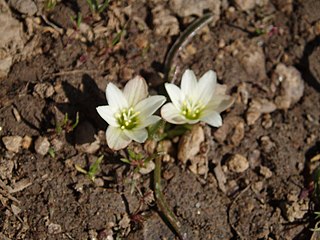
Lewisia nevadensis is a species of flowering plant in the family Montiaceae known by the common name Nevada lewisia. It is native to much of the western United States, where it grows in moist mountain habitat, such as meadows. This is a small perennial herb growing from a taproot and caudex unit. It produces a basal rosette of several narrow, fingerlike to threadlike fleshy leaves up to 13 centimeters long. The inflorescence is a bundle of short stems a few centimeters tall each bearing a flower. The flower has 5 to 10 shiny white to pale pink petals each 1 to 2 centimeters long, pointed or with blunt tips. At the center are many stamens. This is sometimes grown as an ornamental plant suitable for alpine and rock gardens.

Lilaea is a monotypic genus of aquatic plants containing the single species Lilaea scilloides, which is known by the common names flowering quillwort, awl-leaf lilaea, and simply lilaea. The taxonomy of this plant has been in debate, with some authors assigning it to a family of its own named Lilaeaceae, and others keeping it in the small arrowgrass family, Juncaginaceae. It is native throughout the Americas and it can be found elsewhere as an introduced species, particularly in Australia. This is an annual herb growing in or just next to water in several types of shallow aquatic habitat, including vernal pools, mudflats, and ditches. The plant takes the form of a tuft of basal leaves around a very short stem. Each onionlike leaf is very narrow, long and pointed, reaching 25 to 40 centimeters long. It is wrapped in a translucent sheath at the base. The inflorescences include clusters of staminate and bisexual flowers at the tip of a narrow stalk as well as pistillate flowers in underwater axils. The pistillate flower is composed of a threadlike style which may be up to 20 centimeters long tipped with a stigma which floats on the water surface. The fruit is a beaked, ribbed nutlet up to a centimeter long.
Mentzelia congesta is a species of flowering plants in the family Loasaceae known by the common name united blazingstar.
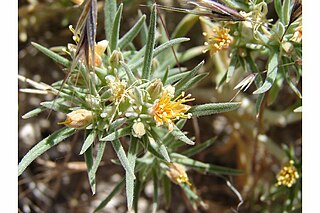
Mentzelia torreyi is a species of flowering plant in the family Loasaceae known by the common name Torrey's blazingstar. It is native to the western United States where it grows in the Great Basin and surrounding areas in desert, scrub, woodland, and other habitat.

Pedicularis centranthera is a species of flowering plant in the family Orobanchaceae known by the common names dwarf lousewort and Great Basin lousewort. It is native to the western United States from eastern Oregon and California to Colorado and New Mexico, where it grows in sagebrush and other basin and plateau habitat. It is a perennial herb producing several short stems a few centimeters tall from a basal caudex. The leaves are up to 20 centimeters long, lance-shaped and divided into many overlapping toothed, wrinkled, or fringed lobes. The inflorescence is a short raceme bearing many long, protruding, club-shaped flowers. Each flower may exceed 4 centimeters in length and is white or pale purple with dark purple tips on the wide ends of its upper and lower lips. The sepals of the flowers are shorter and hairy. The fruit is a capsule around centimeter long containing seeds with netlike surfaces.
Perideridia lemmonii is a species of flowering plant in the family Apiaceae known by the common names Lemmon's yampah and tuni. It is native to the western United States, where it is known from southeastern Oregon, western Nevada, and the mountains of eastern California. It grows in meadows, forests, and other habitat. It is a perennial herb approaching one meter in maximum height, its slender, erect stem growing from usually a single small tuber about 1.5 centimeters long. Leaves near the base of the plant have blades up to 30 centimeters long divided into one or two pairs of leaflets, each of which may be subdivided. The inflorescence is a compound umbel of many spherical clusters of small white flowers. These yield ribbed, round or oblong-shaped fruits each under half a centimeter long.
Sagittaria longiloba is a species of flowering plant in the water plantain family known by the common name longbarb arrowhead and Gregg arrowhead. It is native to the south-central and southwestern United States plus Mexico, Venezuela and Nicaragua. It is also reportedly naturalized in the western Himalayas of India and Bhutan. It grows in slow-moving, stagnant, and ephemeral water bodies such as ponds and small streams, and sometimes disturbed and cultivated habitat such as rice fields and irrigation ditches.

Stellaria nitens is a species of flowering plant in the family Caryophyllaceae known by the common names shiny chickweed and shining starwort. It is native to western North America, including British Columbia, Alberta, and the western United States, its distribution extending into Mexico at least as far as Baja California. It grows in many types of habitat, in dry and moist areas, and sometimes in disturbed places. It is an annual herb producing a slender, upright, four-angled stem from a thin taproot, reaching up to about 25 centimeters in height. Most of the leaves are located low on the stem, each measuring up to 1.5 centimeters long, with smaller, narrower leaves occurring above. The leaves are hairless except for some rough hairs along the margins, and the blades have shiny surfaces. The inflorescence bears a few flowers on short pedicels. The flower has five pointed sepals each a few millimeters long. There are sometimes five tiny white petals as well, though these are often absent.
Tetradymia tetrameres is a species of flowering plant in the aster family known by the common name fourpart horsebrush and dune horsebrush. It is native to the Great Basin, where it occurs in western Nevada and just over the border in Mono County, California. It is a plant of dry scrub and sand dunes. It is a bushy, woolly shrub with many erect, spineless branches. It is the largest of the horsebrushes, growing up to two meters in height. The soft, woolly leaves are narrow and threadlike, growing up to 4 centimeters long. Shorter leaves occur in clusters around the primary leaves. The inflorescence bears 4 to 6 flower heads which are each enveloped in four or five woolly phyllaries. Each head contains up to four or five light yellow flowers each around a centimeter long. The fruit is a hairy achene which may be up to a centimeter long, including its pappus of long bristles.
Eremocrinum is a monotypic genus of plants in the subfamily Agavoideae containing the single species Eremocrinum albomarginatum. It is known by the common names Utah solitaire lily, Intermountain false-wheatgrass, desert lily, lonely lily, and sand lily. It is native to the western United States, where it is known from Arizona and Utah.
Calamus erectus, also known as viagra palm and locally as tynriew, tara, and zhi li sheng teng, is a flowering shrub in the family Arecaceae. The specific epithet (erectus) refers to the plant's habit of growing straight rather than creeping or climbing like many species of the genus Calamus.
